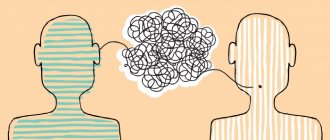Escapism is a phenomenon that represents the individual’s isolated and conciliatory tendency to slip away into an illusory universe, hiding from reality. Simply put, the phenomenon under consideration, escapism, lies in the desire of a human subject or part of a social association to move away from the generally accepted model of social life. The basis of escapism is uncertainty about the reasonableness of generally established norms that form the basis of the ideas of society. The result is a critical rethinking of such norms. For the phenomenon of escapism to arise, it is necessary for society to reach the peak level of its own development, at which social disadaptation and detachment from society do not lead to death, as in primitive society, when ostracism was often chosen as a punishment for offenses and criminal acts.
What is escapism?
Escapism is the desire to escape, hide, or withdraw from reality by engaging in illusions or intense activities. The term “escapism” is derived from the English word escape (“escape”, “to run away”), which is familiar to every computer user, since it is present in an abbreviated form on any modern keyboard.
There are different forms of manifestation of escapism. A person can immerse himself in books, films and TV series, television shows and computer games . Sometimes escapism manifests itself in more active (and often very productive) activities, such as sports, handicrafts, creativity and all kinds of hobbies. But much more often it is some kind of “pseudo-activity” that gives a person a feeling of movement, but does not lead to any result (and, therefore, does not take him out of his comfort zone).
Many authors argue that in the modern world, many more people demonstrate a penchant for escapism. This is explained by the fact that living conditions are now quite comfortable and carefree. Every person knows that he lives in a relatively safe world, and in order to feed himself and his family, he only needs to do his job well and responsibly. At the same time, he has a lot of time left for hobbies and entertainment, allowing him to escape from reality, which is often far from ideal.
The term "escapism" has appeared relatively recently. In 1939, this word was included in Webster's dictionary. And the phenomenon itself manifested itself very clearly after the end of World War II. This was the heyday of the creative activity of many writers who wrote fairy tales and stories in a style that allows the reader to be completely immersed in the world of the main characters, distracted from reality.
For example, Tove Jansson showed in her fairy tales a world over which some terrible threat always hangs, but everything always ends happily. And adults liked her books no less than children, because Moominvalley was a reflection of the real world before, during and after the war. And Astrid Lindgren came up with Pippi Longstocking to show that a person can have great strength (that is, power), but not abuse it. Reading such tales is a form of escapism that many adults resort to.
In the post-war years, books by John Tolkien (Tolkien) became incredibly fashionable. His work is notable for the fact that he created an entire universe with a finely developed mythology , in which the actions of his books take place.
This allows fans to be completely immersed in this universe, reading one story, and then move on to other stories without leaving it. Today, immersion in Tolkien's fairy-tale worlds is one of the most common forms of escapism.
What is all this for?
All practices of increasing awareness and getting closer to your true essence have one goal - to lift the “veil” between the human and the divine in yourself, to live your true essence, to be present in every moment of your life, and also to maintain awareness after death. All this is called in different teachings with one simple word “Awakening”. The highest goal of human development is to wake up in your real life and see the world as it is, creating your true will and being free from illusions.
Examples of escapism
The most common example of escapism is the immersion in works of art described above. It is also worth noting that the writers themselves, for the most part, are escapists (in particular, the aforementioned Astrid Lindgren, Tove Jansson and John Tolkien themselves talked about how they immersed themselves in the fairy-tale and fantasy worlds they created ). This is not surprising, because creating a literary masterpiece really requires the author to immerse himself in a fictional world.
In the modern world, an increasingly common example of escapism is immersion in various forms of virtual reality. If a person does not have some of Maslow’s basic needs met, he can find solace in the world of online games, where he will have a high level and the most expensive weapons, and his name will occupy the top lines in the game rankings. Or he can spend time on social networks , where he will look successful and happy to everyone, because he publishes only the best photos there.
The peculiarity of both situations described above is that a person not only pretends to be a successful person, but actually feels successful. Coming home in the evening and logging into a game or social network, he is completely immersed in this world, distracted from life’s problems and enjoys the significance of his virtual achievements.
Sometimes escapism manifests itself in much more active activities. People facing personal problems try to find a way to distract themselves. They throw themselves into work, immerse themselves in hobbies, and play sports. Probably, everyone knows the situations when a guy or girl, after a painful breakup, dramatically changes their lifestyle, becomes an adherent of a healthy lifestyle, and starts going to the gym (this behavior is typical for those who have been dumped, but not for those who have dumped).
Symptoms
To recognize a disorder, you need to know its symptoms. During derealization, a person is in the following state:
- The feeling that there is a “veil” or “haze” in the head. Visual images are perceived as if in a fog.
- Perception of signals from the surrounding reality with some delay.
- Everything that happens at a given moment is perceived as a movie or a dream, and the person himself feels like an outside observer. Patients often talk about a feeling of unreality of what is happening.
- Inability to obtain a positive emotional response from things and activities that previously brought pleasure.
- Visual and auditory perception is dulled. The colors become faded and the sounds become muffled. Tactile perception may also be impaired and taste buds may be temporarily disabled. Food and drinks seem tasteless.
- The sense of time is distorted. A person may say that all processes have frozen or are moving too quickly.
In severe forms of the disorder, short-term memory loss may occur. After an attack, a person is unable to remember who he talked to today, what he ate, etc.
The most important symptom of derealization and depersonalization is the person's extreme anxiety about the condition. Based on this sign, the psychotherapist can assume the presence of a disorder in the patient.
Types of escapism
The best way to understand what escapism is is to understand its basic forms. There are a huge number of different manifestations of this psychological phenomenon, which are not limited to the examples above. Moreover, depending on the initial reason, three main types of escapism can be distinguished:
- Avoiding discomfort. This is a common and fairly harmless form. If some circumstances are unpleasant for a person, he tries to occupy his thoughts with something else so as not to think about them. Sometimes he may even “close himself off” from people he finds unpleasant, with whom he is forced to communicate regularly (for example, at work).
- Escape from problems. This form of escapism is common to almost all people. For example, if a person is very tired from work or is faced with some problems that put a lot of pressure on him, he can find some kind of distraction for himself: take a day off, go to the cinema, play a computer game. After this, having rested slightly from the problem, he returns to it with renewed vigor and solves it.
- Escape from reality. This form is the most severe and dangerous. If some difficulties in life seem insurmountable to a person, he begins to distance himself more and more from reality. As a rule, this is accompanied by addictive behavior. He begins to drink alcohol or more dangerous psychotropic substances, and sometimes suffers from severe forms of gambling addiction. Often the behavior of such a person changes so much that it begins to cause serious inconvenience to his loved ones.
Reasons for escapism
When explaining what escapism is, they usually always clarify that it is an attempt to step away from reality in order to avoid some kind of discomfort or make up for the lack of pleasant emotions. However, if you dig deeper, you will find that there are several main reasons that occur most often:
- Diffidence. If a person feels that his social status is not high enough or that he lacks some important resources, he tries to make up for this lack in other areas. Most often this is virtual escapism, but it also happens that people try to increase their importance in real life (for example, by making a large number of friends or participating in some kind of social project).
- Family crises. Situations in families are very different. These could be conflicts, problems with raising children, toxicity of close relatives or problems with their health. A family crisis may well become a factor that will lead to the most severe form of escape from reality if a person suddenly seems to have made a mistake that can no longer be corrected.
- Career problems. Each of us, entering adulthood, makes certain career plans. These plans may or may not be very detailed, but over time, most people have to face the fact that not all their ambitions can be realized. Realizing this, a person begins to escape from reality, devoting all his free time to watching TV series or playing computer games.
- Dissatisfaction with personal and social life. Each of us has a natural need for personal happiness and a rich social life. And very often, dissatisfaction in one of these areas leads a person to start communicating a lot online, thereby compensating for the lack of social or romantic communication. Often social phobes “escape” to online communication, thus satisfying their need for society.
- Loss of interest in life. Sometimes this happens to people. They cease to understand what they are striving for and what they want, they lose the opportunity to dream and make grandiose plans. All they experience is boredom. And trying to find some new meaning in life, they begin to experiment, immersing themselves in social networks, online games, and sometimes even start using psychoactive substances.
Illusions of macrocosm and microcosm: experiments of physicists and neuroscientists
Microcosm and macrocosm are concepts from ancient natural philosophy, meaning small and large “cosmos”, order – man and the Universe. The concept of such a structure of the universe and man is found in many esoteric teachings, and the mythology of different nations contains the myth of the creation of the world from the body of the first man. “As above, so below” - words from the Emerald Tablet of the legendary Hermes Trismegistus.
Recent research by astrophysicists has shown that the world is not as we know it: there is something previously inaccessible to human perception, but certainly exists. These are the so-called Dark Matter and Dark Energy. These substances were discovered quite recently. They are invisible to the human eye and are not recorded by instruments, but their existence is confirmed by the presence of gravitational forces. This force maintains the integrity of the Universe, holding its elements together like glue.
How Dark Matter was discovered: until the 70s of the 20th century, there was an opinion that our Universe is expanding and will continue to expand until the so-called thermal death occurs - a state when matter is distributed evenly throughout the entire volume of the Universe, and the process of energy transfer is no longer possible . However, it gradually became known that the real mass of the Universe is much greater than the mass of its visible parts.
This was first discovered by Swiss astronomer Fritz Zwicky while measuring the speed of movement of one of the galaxies. He was surprised to find that this speed was much greater than it should have been, given the mass of its visible parts. This was a real revolution in physics, because it followed that either the laws of gravity are incorrect, or there is some substance that has this missing mass. It was given the code name “Dark Matter”. In addition to Dark Matter, which is supposedly ordinary matter, Dark Energy is also distinguished - this is a substance that does not obey the usual laws of physics for particles. This energy makes up most of the “content” of the Universe - about 68.3%, while Dark Matter is only 26.8%, and a very small part is made up of the atoms we are used to - 4.9%.
In 1983, neuroscientist Benjamin Libet conducted an experiment proving that human conscious choice is illusory. Sounds creepy, doesn't it? During the experiment, participants were given instructions to choose whether to move their right or left hand. At the same time, the desire to move should have arisen spontaneously. The moment of movement was monitored by sensors, and changes in brain activity (in this case, the area of the cortex responsible for movement) were monitored using electrodes. When the subject decided to make a movement with his hand, the so-called “readiness potential” appeared in the cerebral cortex. At the same time, the participants themselves were asked to record the time when they decided to move their hand.
Neurophysiologists have long known that the readiness potential appears even before the movement itself. But the next discovery surprised the experimenters. It turns out that the subjects’ subjective feeling about making a decision arose a little later than the readiness potential. It was as if the brain had made a decision on its own.
Most people think of the mind as something separate from the physical medium, but Libet's experiment, among other things, proves that thoughts and emotions are indeed generated by impulses inside the brain. And the second misconception that this study dispels is that people know everything about their brains. Alas, it seems so only as long as this complex “machine” works normally. The slightest malfunction proves how little is known about the processes actually occurring there.
The Negative Impact of Escapism
It is impossible to say for sure whether escapism is harmful, since it greatly depends on its scale. If this is a moderate withdrawal from problems for the purpose of a little rest and emotional recharging, then it is rather useful. We all do this regularly, whether we're immersed in a book, playing an online game, or pounding away at a punching bag at the gym. This helps you forget about problems for a while, and then return to solving them with new strength and fresh thoughts.
But sometimes escapism goes too far. In such cases, it can cause serious inconvenience to a person, reducing his productivity and preventing him from doing important things. Feeling that problems are accumulating in some area of life, a person falls into procrastination and devotes less and less time to solving them. And escapism taken to the extreme helps him not to think about these problems. Need I say that such tactics are destructive for any area of life?
How to get rid of escapism?
If you think that escapism is preventing you from living, preventing you from solving problems and making them worse, then you need to get rid of it. A few simple tips will help you with this:
- Understand what you are “escaping” from. Above we examined the main reasons leading to the development of escapism. The first step is to localize them. You can write down the reasons on a piece of paper to make it easier to look at them and analyze them.
- Understand where you are “running away”. It is equally important to understand what exactly is consuming your thoughts. If it is something too intrusive, it makes sense to completely get rid of it or at least greatly limit it.
- Stop pretending. People suffering from escapism eventually develop the habit of pretending in all areas of their lives. But any pretense greatly exhausts a person, robbing him of the energy necessary to solve important problems.
- Limit your time on the computer. You don’t have to completely give up your favorite computer game or social networking right away. But it makes sense to greatly limit these activities.
- Treat yourself. Give yourself some pleasant surprise, have fun with friends or make a purchase that you have long dreamed of. Pleasant emotions give a good boost of energy and help you return to reality.
- Learn to be grateful. This popular advice is also useful in the fight against escapism, because it teaches us to attach less importance to life's problems and difficulties.
- Talk to your loved ones. If you discuss the problem with a loved one, it may turn out that there is no need to run away from it.
Carlos Castaneda: hoaxer or genius?
The most mysterious writer of the twentieth century, the author of many books and the founder of “The Way of the Warrior” - which has been repeatedly criticized and exposed, but still has many followers in all countries of the world. Castaneda retells in his books the teachings of Don Juan, an ethnic Indian and magician. The essence of the teaching is complex and confusing, but the goal is the same - increasing awareness, getting rid of the illusions of this world. This teaching was called the Way of the Warrior. Don Juan believed that someone who has achieved perfection or a person of Knowledge no longer obeys the laws of this illusory reality, since he can create his own. The goal of the warrior’s path is freedom, including freedom from all human needs (for self-affirmation, acceptance, self-worth), including the need for other people’s assessments, and ultimately, the acquisition of personal power. It was Castaneda who was the author of the famous term SSV - Sense of Self-Importance. Castaneda's judgments are quite harsh and straightforward, and he calls Death his best adviser, which ultimately awaits everyone and which should not be forgotten.
“The only truly wise adviser we have is death. Every time you feel, as often happens to you, that everything is going very badly and you are on the verge of complete collapse, turn to the left and ask your death if this is so. And your death will answer that you are mistaken, and that apart from its touch there is nothing that really matters. Your death will say: “But I haven’t touched you yet!” [1].
The practices that Castaneda offers to achieve greater awareness are lucid dreaming, stopping internal dialogue, stalking, as well as internal work: recapitulating the events of one’s own life, searching for “energy leaks” - that which makes one weaker. Castaneda later developed a system of physical exercises that increased awareness and called it Tensegrity. All this gives his teaching a similarity both to the practice of the Fourth Way (working with the body, emotions, avoiding the traps of the mind) and to modern yoga (physical exercise, meditation, energy practices).











